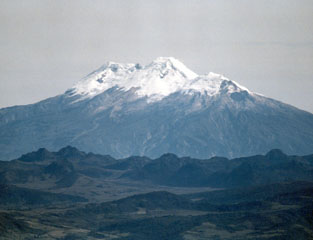Report on Nevado del Huila (Colombia) — 21 January-27 January 2009
Smithsonian Institution / US Geological Survey
Weekly Volcanic Activity Report, 21 January-27 January 2009
Managing Editor: Sally Sennert.
Please cite this report as:
Global Volcanism Program, 2009. Report on Nevado del Huila (Colombia) (Sennert, S, ed.). Weekly Volcanic Activity Report, 21 January-27 January 2009. Smithsonian Institution and US Geological Survey.
Nevado del Huila
Colombia
2.93°N, 76.03°W; summit elev. 5364 m
All times are local (unless otherwise noted)
INGEOMINAS reported that observations and images taken of Nevado del Huila during an overflight on 21 January revealed that the growing lava dome was about 1 km long, in a N-S direction, and 250 m wide, in a E-W direction. The current estimated volume of the dome was 52 million cubic meters. White-and-blue gas plumes were emitted. On 21 and 23 January, gas plumes viewed through the web camera rose to a maximum altitude of 6.3 km (21,000 ft) a.s.l. and drifted W. The Alert Level remained at Orange.
Geological Summary. Nevado del Huila, the highest peak in the Colombian Andes, is an elongated N-S-trending volcanic chain mantled by a glacier icecap. The andesitic-dacitic volcano was constructed within a 10-km-wide caldera. Volcanism at Nevado del Huila has produced six volcanic cones whose ages in general migrated from south to north. The high point of the complex is Pico Central. Two glacier-free lava domes lie at the southern end of the volcanic complex. The first historical activity was an explosive eruption in the mid-16th century. Long-term, persistent steam columns had risen from Pico Central prior to the next eruption in 2007, when explosive activity was accompanied by damaging mudflows.

